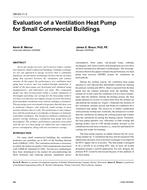Description
Air-to-air energy recovery can be used to reduce ventilation loads for small commercial buildings. Enthalpy exchangers are one approach to energy recovery that is commonly employed. An alternative technology involves the use of a heat pump that operates between the ventilation and exhaust streams. In this paper, the performance of a ventilation heat pump heat recovery unit was studied through simulation. A model of the heat pump was developed and validated using manufacturers’ and laboratory test data. This component model was then incorporated within a system simulation to investigate operating cost savings for the heat pump relative to a base case that does not employ energy recovery but utilizes fixed minimum ventilation rates with an enthalpy economizer. The operating costs were found to be greater than the base case in moderate climates with relatively small savings in more extreme climates (hot or cold). The performance is not competitive with the performance of enthalpy exchangers or demand-controlled ventilation. The breakeven ambient conditions for positive savings utilizing a ventilation heat pump were also investigated. The primary performance penalties associated with the use of a heat pump are added fan and compressor power consumption, along with lost economizer savings.
Units: Dual
Citation: Symposium, ASHRAE Transactions, vol. 111, pt. 1, Orlando 2005
Product Details
- Published:
- 2005
- Number of Pages:
- 11
- File Size:
- 1 file , 6.4 MB
- Product Code(s):
- D-25585




